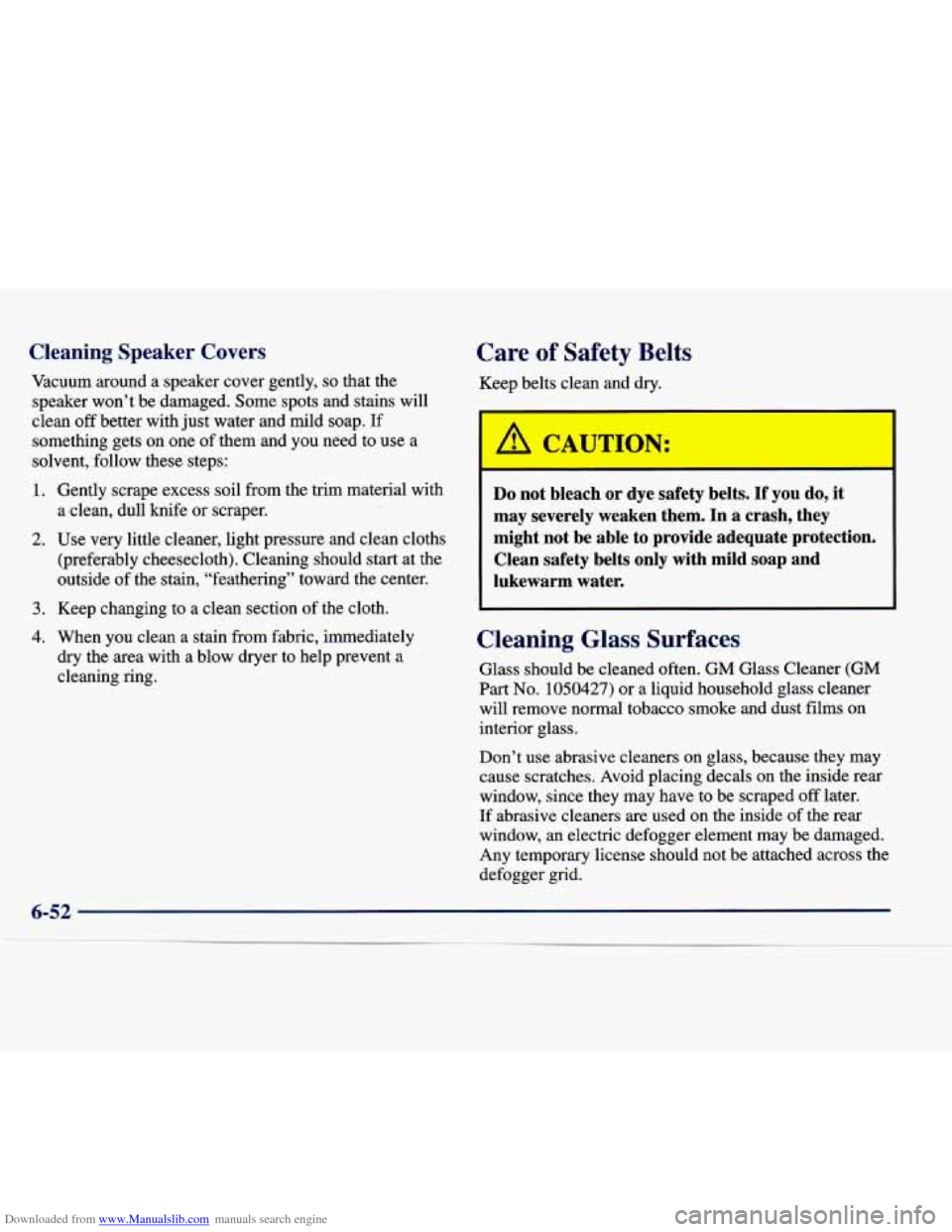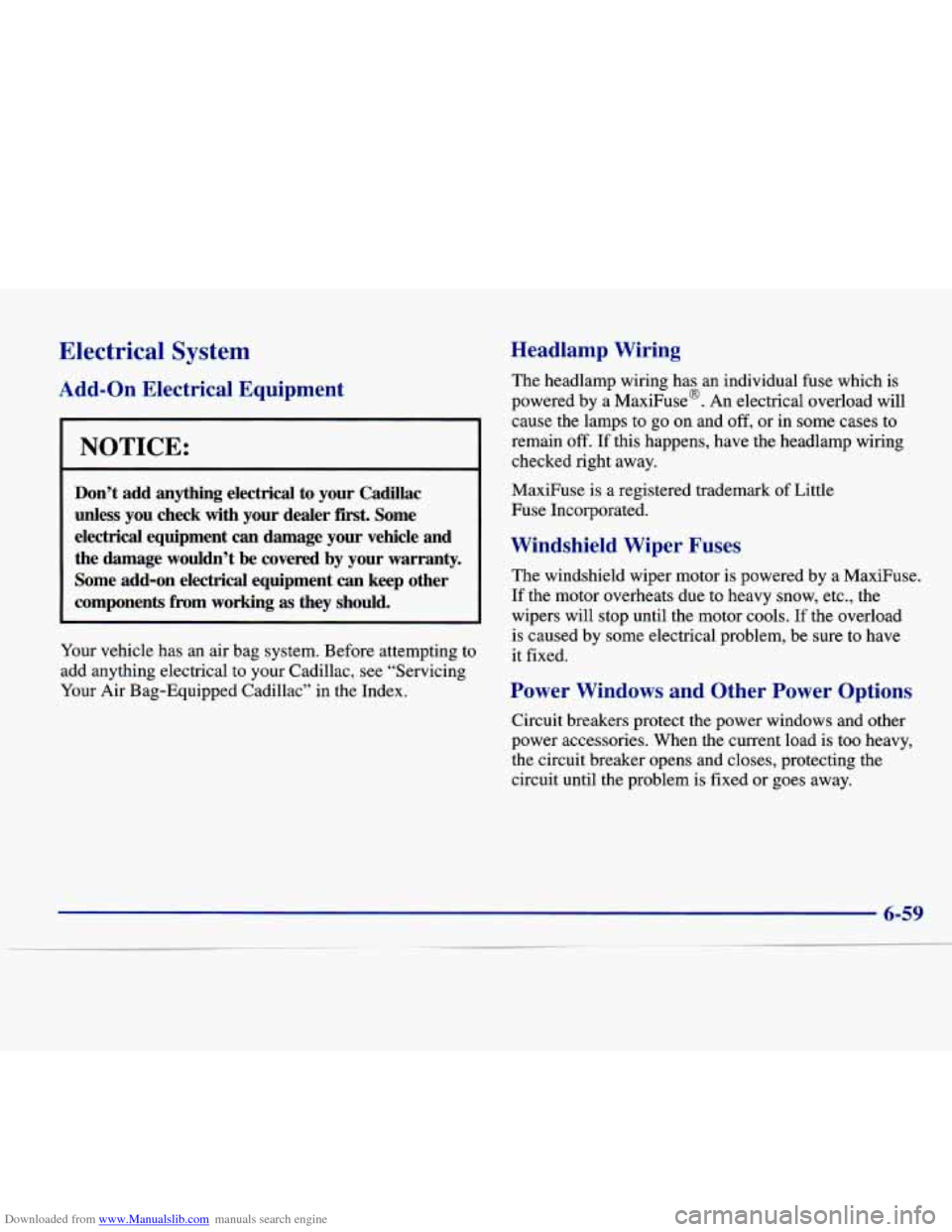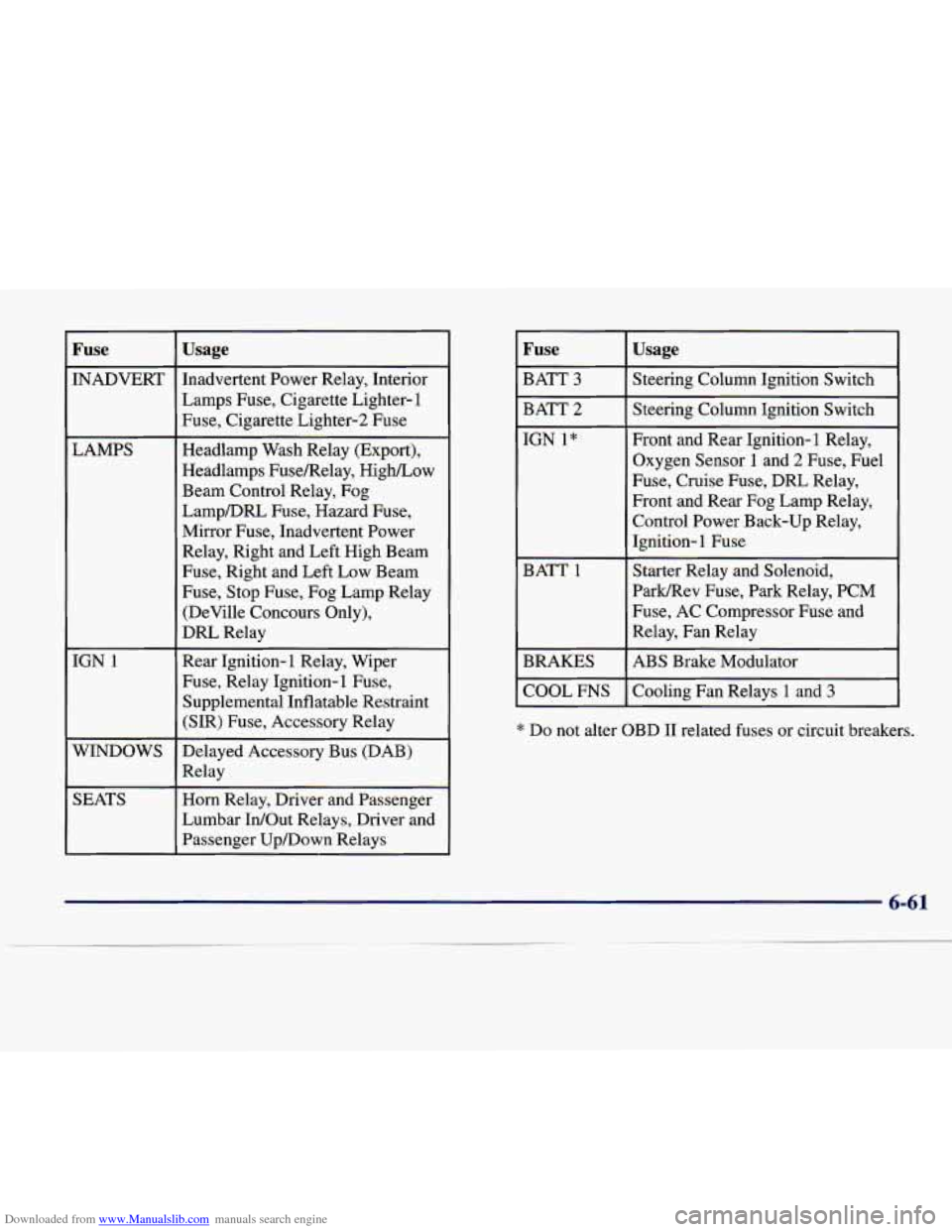window CADILLAC DEVILLE 1997 7.G Owner's Manual
[x] Cancel search | Manufacturer: CADILLAC, Model Year: 1997, Model line: DEVILLE, Model: CADILLAC DEVILLE 1997 7.GPages: 386, PDF Size: 21.61 MB
Page 176 of 386

Downloaded from www.Manualslib.com manuals search engine Defogging and Defrosting
On cool, humid days, use DEFOG (digital cluster
climate control panel only) to keep the windshield and
side windows clear. Use DEFROST to remove fog or
ice from the windshield quickly in extremely humid or
cold conditions.
With the digital cluster climate control panel, press the
DEFOG button and adjust the fan speed by pressing the
fan button up or down.
If you use DEFROST, adjust the
fan speed the same way. If you select DEFROST from
AUTO, the system will control the fan speed. The
temperature will also need to be adjusted to your
comfort level. Press the blue button to decrease the
temperature and the red button to increase the
temperature.
If you have the analog cluster climate control panel,
press the DEFROST button.
If you select DEFROST,
adjust the fan speed by pressing the fan button up or
down.
If you select DEFROST from AUTO, the system
will control the fan speed. The temperature also needs to
be adjusted by turning the TEMP/AUTO knob.
Note that recirculation is not available in the defrost or
defog modes.
Rear Window Defogger
I I
The lines you see on the
rear window warm the glass. Press this button to
turn on the rear defogger.
With it, the rear window
and both outside rearview
mirrors are heated.
The system will automatically shut
off after 10 minutes.
If further defogging is desired, press the button again.
Do not attach a temporary vehicle license, tape or decals across the defogger grid on the rear window.
NOTICE:
Scraping the inside of your rear window could
cut and damage the heating grids. Your warranty
would not cover this damage. And don’t put decals there;
you might have to scrape them off.
3-13
Page 224 of 386

Downloaded from www.Manualslib.com manuals search engine The exit speed is usually posted.
Reduce your speed according to your speedometer, not
to your sense of motion. After driving for any distance
at higher speeds, you may tend to think you
are going
slower than you actually are.
Before Leaving on a Long Trip
Make sure you’re ready. Try to be well rested. If you
must start when you’re not fresh
-- such as after a day’s
work
-- don’t plan to make too many miles that first part
of the journey. Wear comfortable clothing and shoes
you
can easily drive in.
Is your vehicle ready for a long trip? If you keep it
serviced and maintained, it’s ready to
go. If it needs
service, have
it done before starting out. Of course,
you’ll find experienced and able service experts in
Cadillac dealerships all across North America. They’ll
be ready and willing to help
if you need it.
Here are some things you can check before a trip:
0
0
0
0
0
0
0
Windshield Washer Fluid: Is the reservoir full? Are
all windows clean inside and outside?
Wiper Blades: Are they in good shape?
Fuel, Engine Oil, Other Fluids: Have you checked
all levels?
Lamps: Are they all working? Are the lenses clean?
Tires: They are vitally important to a safe,
trouble-free trip.
Is the tread good enough for
long-distance driving? Are the tires all inflated to the
recommended pressure?
Weather Forecasts: What’s the weather outlook
along your route? Should you delay your trip a short
time to avoid a major storm system?
Maps: Do you have up-to-date maps?
Page 230 of 386

Downloaded from www.Manualslib.com manuals search engine 0 Tie a red cloth to your vehicle to alert police that
you’ve been stopped by the snow.
0 Put on extra clothing or wrap a blanket around you.
If you have no blankets or extra clothing, make body
insulators
from newspapers, burlap bags, rags, floor
mats
-- anything you can wrap around yourself or
tuck under your clothing to keep warm.
Snow can trap exhaust gases under your vehicle.
This can cause deadly CO (carbon monoxide) gas
to get inside.
CO could overcome you and kill
you. You can’t see
it or smell it, so you might not
know it is in your vehicle. Clear away snow from
around the base
of your vehicle, especially any
that is blocking your exhaust pipe. And check
around again from time,to time to be sure snow
doesn’t collect there.
Open
a window just a little on the side of the
vehicle that’s away from the wind. This will help
keep CO out.
You can run the engine to keep warm, but be careful.
4-29
.
Page 231 of 386

Downloaded from www.Manualslib.com manuals search engine Run your engine only as long as you must. This saves
fuel. When you run the engine, make it go a little faster
than just idle. That is, push the accelerator slightly. This
uses less fuel for the heat that you get and it keeps the
battery charged. You will need a well-charged battery to
restart the vehicle, and possibly for signaling later on
with your headlamps. Let the heater run for awhile.
Then, shut the engine off and close the window almost
all the way to preserve the heat. Start the engine again
and repeat this only when you feel really uncomfortable
from the cold. But
do it as little as possible. Preserve the
fuel as long as you can. To help keep warm, you can get
out
of the vehicle and do some fairly vigorous exercises
every half hour or
so until help comes.
Loading Your Vehicle
i"
TIRE-LOADING INFORMATION
OCCUPANTS VEHICLE CAP.
WT.
FRT. CTR. RR. TOTAL LBS. KG
MAX. LOADING & GVWR SAME AS VEHICLE
CAPACITY WEIGHT XXX COLD TIRE
TIRE SIZE SPEED PRESSURE
RTG PSliKPa
FRT.
RR.
SPA.
IF TIRES ARE HOT, ADD 4PS1128KPa
SEE
OWNER'S MANUAL FOR ADDITIONAL
INFORMATION
Two labels on your vehicle show how much weight it
may properly carry. The Tire-Loading Information label
found on the driver's door tells you the proper size,
speed rating and recommended inflation pressures for
the tires on your vehicle. It also gives you important
information about the number
of people that can be in
your vehicle and the total weight that you can carry.
This weight is called the Vehicle Capacity Weight and
includes the weight of all occupants, cargo and all
options not installed in the factory.
Page 260 of 386

Downloaded from www.Manualslib.com manuals search engine If No Steam Is Coming From Your Engine
If you get the overheat warning but see or hear no
steam, the problem may not be too serious. Sometimes
the engine can get a little too hot when you:
Climb a long hill on a hot day.
0 Stop after high-speed driving.
0 Idle for long periods in traffic.
0 Tow a trailer.
If you get the overheat warning with no sign of steam,
try this for a minute or
so:
1. Turn off your air conditioner.
2. Dial temperature control to the highest heat setting
and open the window, as necessary.
3. If you’re in a traffic jam, shift to NEUTRAL (N);
otherwise, shift to the highest gear while
driving
-- OVERDFUVE (a) or THIRD (3).
If you no longer have the overheat warning, you can
drive. Just to be safe, drive slower for about
10 minutes.
If the warning doesn’t come back on, you can
drive normally.
If the warning continues, pull over, stop and park your
vehicle right away.
If there’s still no sign of steam, you can idle the engine
for two or three minutes while you’re parked, to see
if
the warning stops. But then, if you still have the
warning,
turn off the engine and get everyone out of the
vehicle
until it cools down. Also, see “Overheated
Engine Protection Operating Mode” listed previously in
this section.
You may decide not to lift the hood but to get service
help right away.
Page 331 of 386

Downloaded from www.Manualslib.com manuals search engine r Fire Chairc
__
NOTICE:
Use tire chains only where legal and only when
you must. Use only
SAE Class “S” type chains
that are the proper size for your tires. Install
them on the front tires and tighten them
as
tightly as possible with the ends securely
fastened. Drive slowly and follow the chain
manufacturer’s instructions.
If you can hear the
chains contacting
your vehicle, stop and retighten
them.
If the contact continues, slow down until it
stops. Driving too fast
or spinning the wheels
with chains on will damage your vehicle.
Appearance Care
Remember, cleaning products can be hazardous. Some
are toxic. Others can burst into flames if you strike a
match or get them on a hot part
of the vehicle. Some are
dangerous
if you breathe their fumes in a closed space.
When you use anything from
a container to clean your
Cadillac, be sure to follow
the manufacturer’s warnings and instructions.
And always open your doors or
windows when you’re cleaning the inside.
Never use these to clean your vehicle:
0 Gasoline
Benzene
0 Naphtha
0 Carbon Tetrachloride
Acetone
Paint Thinner
Turpentine
0 Lacquer Thinner
0 Nail Polish Remover
They can all be hazardous
-- some more than
others
-- and they can all damage your vehicle, too.
Don’t use any
of these unless this manual says you can.
In many uses, these will damage your vehicle:
Alcohol
0 Laundry Soap
Bleach
0 Reducing Agents
6-48
Page 335 of 386

Downloaded from www.Manualslib.com manuals search engine Cleaning Speaker Covers
Vacuum around a speaker cover gently, so that the
speaker won’t be damaged. Some spots and stains will
clean
off better with just water and mild soap. If
something gets on one of them and you need to use a
solvent, follow
these steps:
1. Gently scrape excess soil from the trim material with
a clean, dull knife or scraper.
2. Use very little cleaner, light pressure and clean cloths
(preferably cheesecloth). Cleaning should start at the
outside of the stain, “feathering” toward the center.
3. Keep changing to a clean section of the cloth.
4. When you clean a stain from fabric, immediately
dry the area with a blow dryer to help prevent
a
cleaning ring.
Care of Safety Belts
I
Keep belts clean and dry.
Do not bleach or dye safety belts. If you do, it
may severely weaken them. In a crash, they
might not be able to provide adequate protection. Clean safety belts only with mild soap and
lukewarm water.
Cleaning Glass Surfaces
Glass should be cleaned often. GM Glass Cleaner (GM
Part No. 1050427) or a liquid household glass cleaner
will remove normal tobacco smoke and dust films on
interior glass.
Don’t use abrasive cleaners on
glass, because they may
cause scratches. Avoid placing decals on the inside rear
window, since they may have to be scraped
off later.
If abrasive cleaners are used on the inside of the rear
window, an electric defogger element may be damaged.
Any temporary license should not be attached across the
defogger grid.
Page 342 of 386

Downloaded from www.Manualslib.com manuals search engine Electrical System
Add-on Electrical Equipment
NOTICE:
Don’t add anything electrical to your Cadillac
unless you check with your dealer first. Some
electrical equipment can damage your vehicle
and
the damage wouldn’t be covered by your warranty.
Some add-on electrical equipment can keep other
components
from working as they should.
Your vehicle has an air bag system. Before attempting to
add anything electrical to your Cadillac, see “Servicing
Your Air Bag-Equipped Cadillac” in the Index.
Headlamp Wiring
The headlamp wiring has an individual fuse which is
powered by a MaxiFuse@. An electrical overload will
cause the lamps to
go on and off, or in some cases to
remain off. If this happens, have the headlamp wiring
checked right away.
MaxiFuse
is a registered trademark of Little
Fuse Incorporated.
Windshield Wiper Fuses
The windshield wiper motor is powered by a MaxiFuse.
If
the motor overheats due to heavy snow, etc., the
wipers will stop until the motor cools. If the overload
is caused by some electrical problem, be
sure to have
it fixed.
Power Windows and Other Power Options
Circuit breakers protect the power windows and other
power accessories. When the current load is too heavy,
the circuit breaker opens and closes, protecting the
circuit until the problem is fixed or goes away.
6-59
,~
Page 344 of 386

Downloaded from www.Manualslib.com manuals search engine Fuse
INADVERT LAMPS
IGN
1
WINDOWS
SEATS
Usage
Inadvertent Power Relay, Interior Lamps Fuse, Cigarette Lighter-
1
Fuse, Cigarette Lighter-2 Fuse
Headlamp Wash Relay (Export),
Headlamps Fusemelay, High/Low
Beam Control Relay, Fog
LampDRL Fuse, Hazard Fuse,
Mirror Fuse, Inadvertent Power
Relay, Right and Left High Beam
Fuse, Right and Left Low Beam
Fuse, Stop Fuse, Fog Lamp Relay
(DeVille Concours Only),
DRL Relay
Rear Ignition-
1 Relay, Wiper
Fuse, Relay Ignition-1 Fuse, Supplemental Inflatable Restraint
(SIR) Fuse, Accessory Relay
Delayed Accessory Bus (DAB)
Relay
Horn Relay, Driver and Passenger
Lumbar
In/Out Relays, Driver and
Passenger Upmown Relays
Fuse
Front and Rear Ignition- 1 Relay,
IGN l*
Steering Column Ignition Switch
BATT
2 Steering Column Ignition
Switch
BATT
3
Usage
Oxygen Sensor 1 and 2 Fuse, Fuel
Fuse, Cruise Fuse, DRL Relay,
Front and Rear Fog Lamp Relay,
Control Power Back-up Relay,
Ignition-
1 Fuse
BATT
1 Starter Relay and Solenoid,
ParMRev Fuse, Park Relay, PCM
Fuse, AC Compressor Fuse and
Relay, Fan Relay
BRAKES
* Do not alter OBD I1 related fuses or circuit breakers.
Cooling
Fan Relays
1 and 3 COOL FNS
ABS Brake Modulator
6-61
___~
Page 374 of 386

Downloaded from www.Manualslib.com manuals search engine Cigarette Lighter ............................... 2-6 1
Circuit Breakers and Fuses ....................... 6-62
Cleaner. Air
................................... 6-15
Cleaning Aluminum or Chrome Wheels
................... 6-54
Fabric
................................. 6.49. 6.50
Glass
....................................... 6-52
Inside of Your Cadillac
........................ 6-49
Instrument Panel
............................. 6-5 1
Leather
..................................... 6-51
Outside of Your Cadillac
....................... 6-53
Speakercovers
.............................. 6-52
Special Problems
............................. 6-50
Stains
................................. 6.50. 6.51
Tires
....................................... 6-55
Vinyl
....................................... 6-51
Wheels
..................................... 6-54
Windshield and Wiper Blades
................... 6-53
WoodPanels
................................. 6-51
Climate Control Personalization
................... 3 . 14
Climate Control. Steering Wheel Controls
........... 3-14
Climate Control System
........................... 3-2
Clock. Setting the
............................... 3- 15
Coinholder
.................................... 2-59
Comfort Controls
................................ 3-2
Compact Disc Care
............................. 3-32
Compact Disc Player
............................ 3-26
Compact Disc Player Errors
....................... 3-29
Compact Spare Tire
............................. 5-35
Compass, Rearview Mirror with
................... 2-55
Console Shift Lever
............................. 2-3 1
Continuous Variable
- Real Time Dampening ......... 2-96 Control
of a Vehicle .............................. 4-6
ConvenienceNet
............................... 2-60
Convex Outside Mirror
.......................... 2-59
Coolant
....................................... 6-21
Heater. Engine
............................... 2-23
SurgeTank
.................................. 5-20
Cooling System
................................ 5-18
Cornering Lamps
............................... 2-47
Courtesy Lamps
................................ 2-51
Cruise Control
................................. 2-41
Cruise Engaged Message
......................... 2-91
Cupholders
............................... 2.59. 2.60
Customer Assistance for Text Telephone Users
......... 7-4
Customer Assistance Information
................... 7-1
Customer Satisfaction Procedure
.................... 7-2
CV-RTD (CV-RSS)
............................. 2-96
Damage. Finish
............................... 6-55
Damage. Sheet Metal
............................ 6-55
Daytime Running Lamps ......................... 2-46
DeadBattery
................................... 5-4
Defects. Reporting Safety
................... 7-12. 7.13
Defensive Driving
............................... 4-2
Defogger. Rear Window
......................... 3-13
Defogging
.................................... 3-13
Defrosting
.................................... 3-13
Digital Cluster Climate Control Panel
................ 3-2
Digital Control Buttons
.......................... 2-85
Dimensions.
Vehicle ............................ 6-70
DIC .......................................... 2-85
Dolby' B Noise Reduction
............. 3- 18.3-21. 3-25